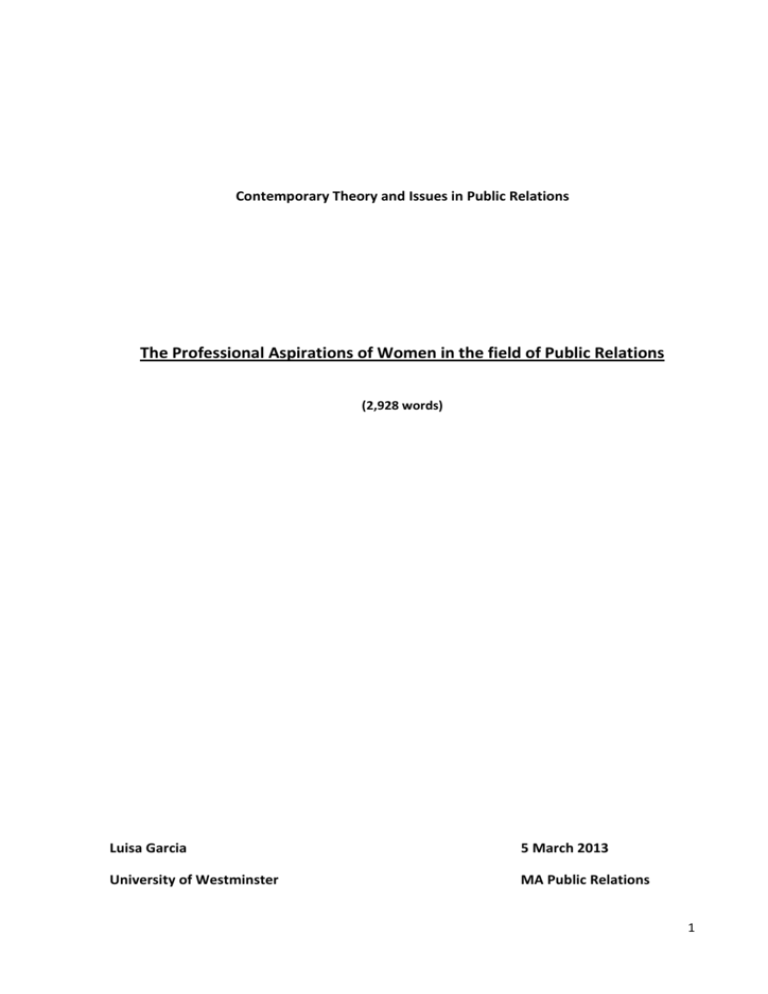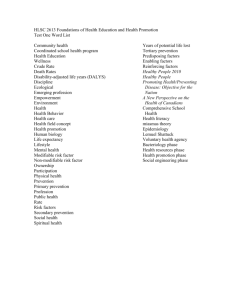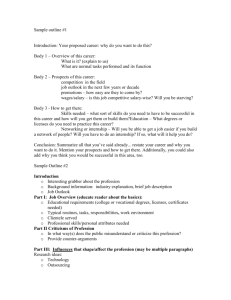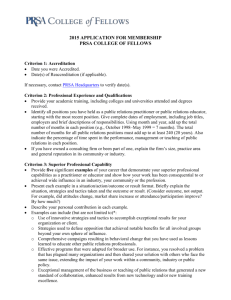
Contemporary Theory and Issues in Public Relations
The Professional Aspirations of Women in the field of Public Relations
(2,928 words)
Luisa Garcia
5 March 2013
University of Westminster
MA Public Relations
1
The Professional Aspirations of Women in the field of Public Relations.
For approximately thirty years the field of Public Relations has been considered as being one of
women. Its feminization process began in the 1980’s and has continued to develop since then,
reaching a point in which females in countries such as the United States and the United Kingdom
represent close to 70% of the total number of practitioners, compared to 46% of the workforce as a
whole (Tench and Yeomans, 2009, page 161 and CIPR 2011 State of the Profession Survey).
Though authors such as Morris and Goldsworthy (2008, pages 17-18) note that “there is no public
evidence that a majority of women in the industry believe there is a glass ceiling holding them back
or that they are discriminated against”, studies of women in Public Relations have consistently found
that there exists a salary gap with respect to men and a “glass ceiling” which impedes female
promotions and ascension to management positions (Cutlip, Center and Broom, 2009, page 62). In
fact, despite women's overwhelming presence in the industry, 80 percent of upper management in
PR is male (Sebastian, 2011) and women continue to earn approximately 75 percent of what men
earn.
As stated by Fitch and Third (2010, pages 1, 8 and 9), “gender inequalities [in public relations] persist,
often in a form that is difficult to pinpoint and therefore difficult to challenge” to which is added the
fact that because women constitute the majority of public relations students, practitioners and
professional association members, “the gender issue” has ceased to be a focus for analysis and is
under- theorized.
Nevertheless, recent studies and journal articles about the glass ceiling prove that it is still a current
issue which is subject to debate and has prompted certain authors to question whether the
feminization of public relations has led to the devaluation of female practitioners and to the
marginalization of the field itself (Brunner, 2006, page 1), while others such as Fitch and Third (2010,
page 1) argue that it has had a positive effect on the industry’s professional status and organizational
cultures. Although these matters are not agreed upon, there is consensus among experts regarding
the existence of a glass ceiling which limits women’s professional aspirations within the field.
This is supported by the 2012 CIPR State of the Profession Survey, which shows that 45% of men in
the profession earn a salary in excess of £50,000, compared to just 25% of women. Furthermore,
women are much more likely to hold executive/officer level (20% compared with 12% of men) or
manager level positions (28% compared with 19% of men), while men are more likely to be in senior
2
management (8% compared with 6% of women), director (19% compared with 11% of women) or
partner level positions (13% compared with 11% of women). Added to this the 2010 ECM Survey
indicates that only 4 out of every 10 respondents, of which the majority are women, are satisfied
with their career opportunities, work-life balance and salary.
There also appears to be a clear gender divide in the United States and the United Kingdom with
respect to specialties within the field of public relations. According to Morris and Goldsworthy
(2008, page 17) men dominate higher earning sectors, such as lobbying, political and financial PR,
while women fulfill supporting roles and focus on event-planning, fashion and beauty. 70% of women
work in consumer and lifestyle PR, which are traditionally less remunerative than the areas
previously mentioned. In the words of Yaxley (2011): “In the publicity arena, men are typified as able
to control the media on behalf of their high profile clients, whilst women are party-organisers”.
These differences are taken into consideration by female students who, despite the knowledge that
male-oriented sectors are higher-paying, are more likely to choose female-oriented specialties when
deciding their career paths, which might suggest that they perceive that their gender may matter in
terms of how quickly they advance within certain specialties of PR (Andsager and Hust, 2005, pages
85, 89 and 90).
As professionals, while both men and women prefer the notion of holding managerial roles and enjoy
managerial tasks (Geyer-Semple, 2011, pages 7 and 12) female PR practitioners perceive that they
have less organizational influence than do men, both on the technician and managerial levels
(Verhoeven, 2010, pages 1 and 12). This issue in itself is of concern both among academics and
among female managers, as expressed by Sally Costerton, chairman and CEO of Hill & Knowlton
EMEA and president of the PRCA (through Woods, 2011), who declares that “there remains the
perennial question of why there are not enough women in agency leadership roles in the UK. I want
to see more. As they enter their thirties, they should be going for head of communications roles”.
In this regard, academics point to several reasons which might be contributing to the gender gap in
the field of public relations. The most extended theory is that women are at a professional
disadvantage as they are the main carers for their children. As shown in a recent U.N. report, women
spend at least twice as much time on housework and child care as do men (Salzman, 2010) and are
primarily accountable both for running their households and for managing the relationship between
home and the workplace(Daymon and Surma, 2012, page 181). Nonetheless, while experts such as
Morris and Goldsworthy question the fairness of this situation and acknowledge that “they may
3
affect the makeup of the industry” (2008, page 17), others argue that care-giving cannot be blamed
for the gender gap. Research carried out by Dozier and Bei-Ling shows that when comparing the
salaries of women who do not leave their jobs with those of women who do so to have children and
then come back, there are no significant differences between the two (Bei-Ling, through Commpro,
2011).
A second reason that is given for the existence of a glass ceiling is that men in the PR profession are
more likely to be both older and in more senior positions than are women (CIPR State of the
Profession Survey). While the reasons for this are unknown (Dozier, 2011) men have an average
industry experience of 11.1 years versus a female average of 8.2 years (Morris and Goldsworthy,
2008, page 17). These figures are supported by Grunig and Dozier (through Fitch and Third, 2010,
page 6), who initially argued that over-representation of women in technical roles “had more to do
with years of professional experience and length of time with an employer, than gender”. However,
Fitch and Third (2010, page 6) are of the opinion that this view assumes that the concept of gender
“can be separated neatly from levels of professional experience and employer loyalty and proffer an
explanation that rationalises the problem in terms of women’s individual employment histories”,
downplaying the gendered basis of the industry in doing so.
In addition, women in public relations are victims of stereotypes (Cutlip, Center and Broom, 2009,
page 62). The profession of PR is portrayed as glamorous and soft (Geyer-Semple, 2011, page 4) and
the women within it are typified as beautiful and glamorous celebrity party-planners. There is
general agreement among academics that “sex- based stereotypes have worked against women in
public relations” (Grunig, Toth and Hon, page 23), that they have led people “to perceive women as
less powerful or empowered than they actually are” and that they have made women be seen as
weaker and less competent than men (Verhoeven, 2010, pages 1 and 3). Therefore, authors such as
Tench and Yeomans (2009, page 161) sustain that these stereotypes are one of the main reasons why
most women only fulfill roles as technicians and occupy a relatively low status in the organizational
structure. In this regard, stereotypes create gender-based expectations which affect the demands of
employers which in turn reinforce supposed gender-specific expectations (Froehlich, 2004, page 9).
“With a structure in place that traditionally has men in power, has a history of developing
organizational rules and regulations to keep them in power, and a socialization process that, early on,
reinforces sex typing in jobs and gender roles, the status quo remains firmly in place. The glass ceiling
remains intact” (Wrigley, 2002, page 48). Moreover, Grunig, Toth and Hon (2001, page 91) argue that
organizational culture itself may contribute to discrimination against women, and that changes
should be made with respect to it so as to ensure equal labour rights for women. Nevertheless,
Radical feminist perspectives question whether will ever change unless women acknowledge that the
4
structure needs to be dismantled (Wrigley, 2002, page 44). As noted by Wrigley (2002 pages 11, 1617) many women in PR deny or ignore the fact that there is a glass ceiling and therefore blame
themselves and their lack of experience, credentials, or hard work for their inability to make
professional progress” and perceive themselves as lacking the necessary negotiation skills and
knowledge to request higher salaries (Aldoory and Toth, through Geyer-Semple, 2011, page 3). In
turn, this might be the reason why some academics perceive women as lacking the ambition needed
to reach managerial roles and as being more content in the role of public relations technicians
(Broom and Dozier, through Geyer-Semple, 2011, page 2).
While the causes of the PR gender gap may be uncertain, its consequences are quite clear.
Stereotypical perceptions might lead to unequal distributions of gender roles and power among male
and female practitioners and ultimately to the increased or decreased power of the public relations
function within organizations depending on the gender of its practitioners (Verhoeven, 2010, page
12). Different tasks are assigned to men and women in response to the demands and gender role
expectations of clients (Yeomans, 2010, page 12) and of managers themselves, causing many
communicators to be concerned that the avenues to senior management “may become closed for
them, especially if they are stereotyped as technicians with few management skills” (Cline et al.,
1986, page 2). Thus, many women reject being assigned traditionally female roles of media relations
or events management and leave their positions to start their own PR firms, in hopes of gaining
professional recognition while achieving more flexible schedules which would allow them to balance
their work and personal lives (Daymon and Surma, 2012, page 186).
Ultimately, the glass ceiling might affect the number of years that women remain in the profession
(Edwards, 2010, page 29), and thus the number of female role models and mentors (Grunig, Toth and
Hon, 2001, pages 89-90) who would show women how to navigate their careers successfully and
inspire them to be ambitious and grow professionally. Therefore, many experts agree with
Clemmons (2010), who declares that “accepting things the way they are or opting out of traditional
work environments is not the answer”.
In truth, the solutions which have been suggested for the issue are varied. While some theorists
adopt a passive viewpoint regarding the issue, stating that “more women enter the profession and
accumulate experience the differential should reduce” (Morris and Goldsworthy, 2008, page 17)
others prefer a more active stance, similar to that proposed by The Velvet Ghetto study (Cline at al.,
1986, page 5) which suggested taking measures for improving the status of the profession, working
with students, increasing awareness and mentoring. In other words, it proposed a series of changes
that Hon (through Tench and Yeomans, 2009, page 162) divides into four categories: societal,
5
organizational, professional and individual, which are needed so as to overcome the stereotypes that
dominate many areas of PR (Yaxley, 2011).
The first step towards progress, as most academics agree, is to talk about the problem so that it is
recognized as such (Bei-Ling, through Commpro 2011) by women at all levels in PR. Female students
should be informed of the opportunities and challenges they will face and be assisted in selecting a
workplace that matches their goals (Wrigley, 2002, page 49-50), while emphasizing that they should
feel free to pursue any specialty they desire (Andsager and Hust, 2005, page 90) and taking into
account that some women find agencies more welcoming than corporate environments (Wrigley,
2002, page 50). In this regard, Cutlip, Center and Broom (2009, page 62) remark that women must
develop career plans and select employers with care, develop management skills, have higher salary
expectations and not undervalue themselves. This can be encouraged through mentoring programs
(Tindal, 2010; Wrigley, through Geyer-Semple, 2011, page 5). By showing them other women who
have become managers themselves and making them highly visible, their confidence could be built
up, inspiring them to work toward a managerial role (Grunig, Toth and Hon, 2001, page 239). As
expressed by Costerton (through Woods, 2011) “Women need to network and learn from other
women. I got this because I wanted it - they have to want it too”.
Mentoring and networking have traditionally been considered male activities (Wrigley, 2002, page
33), and in this regard there are academics who go further and argue that women should adopt a
more masculine professional style overall (Grunig, Toth and Hon, 2001, pages 351-353). In truth, as
noted by Frohlich, Peters and Leidner (trough Yeomans, 2010, page 10-11) a lot of women relate
professionalism to masculine attributes, such as aggressiveness, toughness and stoicism and use
them in an attempt to counter the “PR girl” stereotype. However, there is debate regarding whether
women should adopt less feminine professional behaviours because, as Heath argues (2010, page
254), women may bring unique attributes and approaches to the business world. While Froehlich
(2010, pages 5 and 9) sustains that these same female characteristics might allow women more
access to the profession at the entry level but are also associated with a lack of assertiveness and
weak leadership skills, Gruning states (through Tench and Yeomans, 2009, page 162) that women’s
“inclusivity, respect, caring, cooperation, equity, self-determination and interconnection could
enhance the ethical and effective practice of PR”. In other words, it is these female characteristics
which best exemplify the principles of best practice in public relations and which are at the base of
the highly regarded Excellence Model of PR.
6
Furthermore, it is the generally accepted assumption that women communicate differently than men
which has lead Verhoeven (2010, page 5-12) to theorize that social media could help break the glass
ceiling in PR. He argues that users of social media tend to be social, involved, dedicated, mediasmart and seek intimacy and that in their communications “cooperation is beneficial, everyone is
equal and everyone can learn from others”. As these traits are connected to a “female style of
communication” it could therefore be assumed that women might feel more comfortable using social
media and might be more apt to use it to initiate dialogue and establish new relationships with
stakeholders. Consequently, women might become more skilled in their use and gain an advantage
over male practitioners. However as noted by Yaxley, who does not accept the notion that women
should be recognized for their softer skills, (2013) “these cannot be the only tools in a PR woman's
toolkit”.
In conclusion, many authors suggest that the situation of women in PR is improving (Cutlip, Center
and Broom, 2009, pages 52 and 62), basing their views on signs of progress such as the fact that
professional bodies such as the CIPR and the PRCA are lead by women. In the words of Yaxley (2011):
“there is evidence of positive movement – albeit in a two-steps forward, one-step back manner”
although, as she goes on to comment “it is evident that men still leapfrog into senior positions from
their previous jobs in journalism or elsewhere in an organisation’s management hierarchy”. In fact,
these views are supported by studies which show that the glass ceiling and gender discrimination
have not been eliminated. Moreover, academics such as Bei- Ling (2011) consider that “as more
women enter public relations, with their lower annual earnings, the average incomes for the
profession as a whole will decrease. This is a simple issue of math”.
The solutions which have so far been proposed for the problem are not simple and would require
some time to take effect. As a first step, women should acknowledge the existence of a gender gap in
PR, understand its barriers and learn from the successful women who found their way around them
(Eagly and Carli, thorough Quast, 2010). More importantly though, as expressed by Edwards (2010,
page 30), is that the profession as a whole should “reflect on its values and norms, its understandings
of ‘difference’ and ‘diversity’, its links to social hierarchies, and its structures, all of which can limit
possibilities for ‘different’ individuals joining or progressing through the PR hierarchy”. As Fitch and
Third argue (2010, page 10), addressing the gender gap and its related issues would have added
effects with regard to the consideration of public relations as a profession, even contributing to
achieve academic legitimacy and professional recognition.
Female practitioners continue to prove their worth so as to gain access to management positions and
equal salaries. As a feminized profession, PR should share the interests of the women who work
7
within it as it faces the same obstacles that they do. Most experts agree that they are both slowly
making progress towards achieving recognition and, as seen, the general consensus among
academics and professionals is that women (and public relations) will, in time, succeed in achieving
their goals. However, before this can happen, further investigation is required to help members of
the profession to understand the true causes of the gender gap and to aid them in the
implementation of effective solutions which will finally break the glass ceiling in public relations.
8
REFERENCES
Bibliography
Cutlip, S. Center, A. and Broom, G.M. (2009) Cutlip and Center’s Effective Public Relations. Pearson
Prentice Hall.
Grunig, L., Toth, E., Hon, L. (2001)Women in Public Relations. How Gender Influences Practice. The
Guildford Press.
Heath, R.L. and Vasquez, G.M. (2nd edition, 2010). Handbook of public relations. Sage.
Morris, T., and Goldsworthy, S. (2008) PR, A Persuasive Industry? Spin, Public Relations and the
Shaping of the Modern Media. Palgrave Macmillan.
Tench, R. and Yeomans, L. (2009). Exploring Public Relations. Second Edition. Prentice Hall.
Online resources
Andsager, J. and Hust, S. (2005) Differential gender orientation in public relations: Implications for
career choices. Public Relations Review (31). Available at:
http://www.oswego.edu/~jung/COM317/Article%20for%20Measurement_Differential%20gender%2
0orientation%20in%20PR.pdf
Bei-Ling, S. (2011) State of Gender Diversity in Public Relations: The Salary Gap Widens. PRSA
Available at: http://diversity.prsa.org/index.php/2011/04/state-of-gender-diversity-in-publicrelations-the-salary-gap-widens/
CIPR 2011 State of the Profession Survey. Available at:
http://www.cipr.co.uk/sites/default/files/CIPR%20Membership%20Survey%20Report%20Nov11%20
with%20foreword.pdf
Clemmons, D. (2010). No love in industry for mothers. PRSA. Available at:
http://diversity.prsa.org/index.php/2010/09/no-love-in-industry-for-mothers/
Cline, C. at al. (1986). The Velvet Ghetto Summary Report. IABC Research Foundation. Available at:
http://www.iabc.com/researchfoundation/pdf/VelvetGhetto.pdf
Commpro. (26 May 2011) PR Gender Pay Gap Research Under Fire: Dr. Sha Addresses Detractors,
Offers Tips for Closing the Divide. Available at: http://www.commpro.biz/public-relations/pr-genderpay-gap-research-under-fire-dr-sha-addresses-detractors-offers-tips-for-closing-the-divide/
Daymon, C. and Surma, A. (2012). The mutable identities of women in public relations. Public
Relations Enquiry. Sage. Available at: http://pri.sagepub.com/content/1/2/177.abstract
9
Dozier, D. (18 April, 2011) No Equal Pay in PR: Today’s Gender Pay Gap of 14% Can Be Blamed on
Discrimination. Commpro. Available at: http://www.commpro.biz/public-relations/no-equal-pay-inpr-todays-gender-pay-gap-of-14-can-be-blamed-on-discrimination/
Edwards, L. (2010). An exploratory study of the experiences of ‘BAME’ PR practitioners in the UK
industry. Industry Report. Manchester Business School. Available at:
http://www.cipr.co.uk/content/policy-resources/research-hub/non-cipr-research-and-reports
Fitch, K. and Third, A. (2010). Working girls: Revisiting the gendering of public relations. Prism.
Available at: http://www.prismjournal.org/fileadmin/Praxis/Files/Gender/Fitch_Third.pdf
Froehlich, R. (2004) Obstacles for Women's Future and Career in Public Relations: Feminine and
Feminist Values as a "Friendliness Trap"? Institut fuer Kommunikationswissenschaft, University of
Munich. Available at: http://conferences.arts.usyd.edu.au/viewpaper.php?id=94&cf=3
Geyer-Semple, V. (2011). Classroom to Boardroom: The role of gender in leadership style, stereotypes
and aptitude for command in public relations. PRSA. Available at:
http://www.prsa.org/SearchResults/view/6D050206/0/Classroom_to_Boardroom_The_Role_of_Gender_in_Leade
Quast, L. (22 November 2010) It's not a Glass Ceiling for Women. It's a "Career Labyrinth". Forbes.
Available at: http://www.forbes.com/sites/work-in-progress/2010/11/22/is-there-really-a-glassceiling-for-women/
Salzman, M. (9 December 2010). Gender Bender. Havas PR Blog. Available at:
http://havaspr.com/us/?p=3659
Sebastian, M.( 3 March, 2011) In the PR world, men still earn more than women. PR Daily. Available
at: http://www.prdaily.com/Main/Articles/7411.aspx#
Tindall, N. (2010) Being mentored to death rather than promoted. PRSA. Available at:
http://diversity.prsa.org/index.php/2011/03/being-mentored-to-death-rather-than-promoted/
Yaxley, H. (15 February 2011) PR- It’s a Woman’s World. PR Conversations. Available at:
http://www.prconversations.com/index.php/2011/02/pr-its-a-womans-world/
Yaxley, H. (20 February 2013). In response to the article Could social media be the end of the “PR
girl”?. The PR Wheel. Available at: http://luisagarciajarrell.wordpress.com/.
Yeomans, L. (2010). Soft sell? Gendered experience of emotional labour in UK public relations firms.
PRism. Available at: http://www.prismjournal.org/fileadmin/Praxis/Files/Gender/Yeomans.pdf
Verhoeven, P. (2010). How European public relations men and women perceive the impact of
their professional activities. PRism. Available at:
http://www.prismjournal.org/fileadmin/Praxis/Files/Gender/Verhoeven_Aarts.pdf
Woods, D. (2011). Profile: Sally Costerton, chairman and CEO of Hill & Knowlton EMEA and president
of the PRCA.PR Week. Available at: http://www.prweek.com/uk/features/1049074/Profile-SallyCosterton-chairman-CEO-Hill---Knowlton-EMEA-president-PRCA
10
Wrigley, B. (2002). Glass Ceiling? What Glass Ceiling? A Qualitative Study of How Women View
the Glass Ceiling in Public Relations and Communications Management. Journal of Public Relations
Research. Available at:
http://www.colinwatsonleeds.co.uk/PGRM/GlassCeilingQUalStudyFocusInts.pdf
Zerfass, A., Verhoeven, P., Tench, R., Moreno, A., & Verčič, D. (2010). European Communication
Monitor. Status quo and challenges for Public Relations in Europe. Results of an empirical survey in 46
countires (Chart Version). EACD, EUPRERA (available at: www.communicationmonitor.eu)
11









